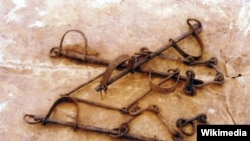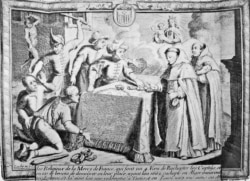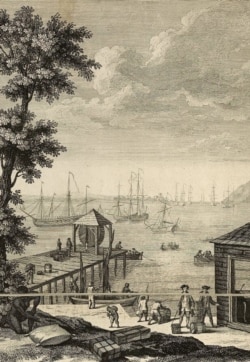In 1614, six years before the Mayflower crossing, English explorer John Smith led two ships to survey the New England coast.
As he described in his “Historie of New England,” Smith left shipmaster Thomas Hunt behind to fish and trade with the Natives. But Hunt saw an opportunity in another kind of trade: He kidnapped 27 Wampanoags and sailed to Spain, where he sold “these poor innocent souls” into slavery.
Among them was Tisquantum, or Squanto, the Wampanoag man from Patuxet (later, Plymouth) who later helped negotiate peace between Pilgrims and Wampanoag Massasoit Ousamiquin and who would help the newcomers through their first year at Plymouth.
Historical accounts state that while Squanto was enslaved, Spanish friars helped him escape to England, where he lived with a shipbuilder and eventually returned to America.
Slavery in America is usually associated with Africa and the American South. But Ohio State University historian Margaret Ellen Newell told VOA that up until 1700, Native Americans comprised the majority of slaves in America.
“The first documented case was in 1605, when an English expedition captured four Wabanakis in what’s now Maine and brought them back to London,” Newell said. “The expedition was run by a man named Ferdinando Gorges, who hoped to establish a colony in northern New England and was looking for captives to use as guides and interpreters.”
Since the start of their settlement, Puritan colonists sought Indians as indentured servants as a solution to labor shortages, she said.
Precedent
Slavery had existed in England in ancient times but declined under Norman rule.
“England didn’t have a clear law of slavery the way that countries in the Mediterranean, who were using Roman law, did,” Newell said.
But English law did allow indentured servitude. Courts could sentence beggars and vagrants with terms of forced labor and even place children into service without parental consent.
The lines between slavery and servitude often blurred, both in England and New England, Newell said.
“Some of these people were set free after a set term as indentured servants,” she said. “But some were kept for life.”
Most New England slaves were placed in Puritan households.
“A lot of economic activity (was) going on in households at all times,” Newell said. “Agriculture, stock raising and many domestic chores. You had to turn raw materials into food and clothing. It all happened in the household.”
Professor Sibylle Scheipers of the University of St. Andrews in Britain said enslavement was a common way to deal with war captives in early Europe. But by the Middle Ages, “religious norms prohibiting the enslavement of Christian adversaries had emerged.”
But treatment of non-Christian adversaries was an entirely different matter, whether in the Crusades or in Africa. In the 15th century, two papal decrees gave Spain and Portugal permission to overthrow “barbarous nations,” convert pagans, seize property and take slaves.
Puritan leaders may also have been inspired by Dutch jurist and scholar Hugo Grotius, who wrote in 1625, “The goods of every particular prisoner, by the right of war, belong to the captors, so the … people in general belong to the conquerors.”
It is against this backdrop that, when Massachusetts and Connecticut colonists went to war with the Pequot Indians in the Connecticut River Valley in 1636, they did not hesitate to enslave those refugees and noncombatant Pequots.
Foreign exports
“They were not only used in New England but were sold to other regions like Bermuda, the Azores islands or English plantations in the West Indies,” Newell said.
Not all colonists were comfortable with Indian slavery, whether out of principle or fear that angry captives posed a threat.
In 1641, Massachusetts passed the so-called Body of Liberties, a list of 98 “rights, liberties and privileges,” as a reference for the General Court.
“The new law essentially banned slavery,” Newell said. “But I think the point was to permit the practice. It started out saying that no one can be enslaved, except people captured in a ‘just war’ — in other words, people like the Pequots.”
Some historians believe that fear of enslavement helped spark the 1675 King Philip’s War between Plymouth Colony and the Wampanoag.
The bloodiest conflict of the period, that war set off a boom in the slave trade. Captives and survivors were put on trial, as detailed in “This Land is Their Land,” by George Washington University historian David J. Silverman. Those who were suspected of committing “hostilities” were hanged; others were sentenced to slavery.
“Perhaps 2,000 Indian women, children and even men who somehow convinced the English they had done no harm received sentences of slavery,” he wrote.
Women and children were taken into households, sometimes as slaves, other times as indentured servants for set terms. Males over the age of 14 were shipped to sugar plantations in Bermuda and the West Indies, where some of their descendants have been identified today.
A legal path to freedom
Enslaved Indians found one important benefit in the colonial legal system: They could petition the courts for their freedom.
“Court cases are a really important source of information on Indian slavery,” Newell said. “They give insight into the methods of enslavement and also how people were fighting back.”
Some Indians convinced juries to free them, she said, which suggests that at least some communities saw Indian slavery as immoral.
Newell said she believes that these lawsuits helped seed the abolitionist movement to free all slaves, African and Indian, especially after the Revolutionary War, in which Native Americans fought side by side with colonists against British rule.
After 1800, courts began imposing prison sentences instead of servitude or slavery for civil and criminal offenders, Newell said.
Massachusetts never passed a formal law ending slavery, and isolated cases of involuntary servitude and slavery persisted even after the 13th Amendment to the U.S. Constitution passed in 1865, banning slavery and servitude “except as a punishment for crime.”









